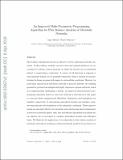| dc.contributor.author | Akbari, Amir | |
| dc.contributor.author | Barton, Paul I | |
| dc.date.accessioned | 2021-10-27T20:10:26Z | |
| dc.date.available | 2021-10-27T20:10:26Z | |
| dc.date.issued | 2018 | |
| dc.identifier.uri | https://hdl.handle.net/1721.1/135037 | |
| dc.description.abstract | © 2018, Springer Science+Business Media, LLC, part of Springer Nature. Flux balance analysis has proven an effective tool for analyzing metabolic networks. In flux balance analysis, reaction rates and optimal pathways are ascertained by solving a linear program, in which the growth rate is maximized subject to mass-balance constraints. A variety of cell functions in response to environmental stimuli can be quantified using flux balance analysis by parameterizing the linear program with respect to extracellular conditions. However, for most large, genome-scale metabolic networks of practical interest, the resulting parametric problem has multiple and highly degenerate optimal solutions, which are computationally challenging to handle. An improved multi-parametric programming algorithm based on active-set methods is introduced in this paper to overcome these computational difficulties. Degeneracy and multiplicity are handled, respectively, by introducing generalized inverses and auxiliary objective functions into the formulation of the optimality conditions. These improvements are especially effective for metabolic networks because their stoichiometry matrices are generally sparse; thus, fast and efficient algorithms from sparse linear algebra can be leveraged to compute generalized inverses and null-space bases. We illustrate the application of our algorithm to flux balance analysis of metabolic networks by studying a reduced metabolic model of Corynebacterium glutamicum and a genome-scale model of Escherichia coli. We then demonstrate how the critical regions resulting from these studies can be associated with optimal metabolic modes and discuss the physical relevance of optimal pathways arising from various auxiliary objective functions. Achieving more than fivefold improvement in computational speed over existing multi-parametric programming tools, the proposed algorithm proves promising in handling genome-scale metabolic models. | |
| dc.language.iso | en | |
| dc.publisher | Springer Nature America, Inc | |
| dc.relation.isversionof | 10.1007/S10957-018-1281-X | |
| dc.rights | Creative Commons Attribution-Noncommercial-Share Alike | |
| dc.rights.uri | http://creativecommons.org/licenses/by-nc-sa/4.0/ | |
| dc.source | arXiv | |
| dc.title | An Improved Multi-parametric Programming Algorithm for Flux Balance Analysis of Metabolic Networks | |
| dc.type | Article | |
| dc.contributor.department | Massachusetts Institute of Technology. Process Systems Engineering Laboratory | |
| dc.relation.journal | Journal of Optimization Theory and Applications | |
| dc.eprint.version | Author's final manuscript | |
| dc.type.uri | http://purl.org/eprint/type/JournalArticle | |
| eprint.status | http://purl.org/eprint/status/PeerReviewed | |
| dc.date.updated | 2019-08-13T15:51:16Z | |
| dspace.orderedauthors | Akbari, A; Barton, PI | |
| dspace.date.submission | 2019-08-13T15:51:17Z | |
| mit.journal.volume | 178 | |
| mit.journal.issue | 2 | |
| mit.metadata.status | Authority Work and Publication Information Needed | |
